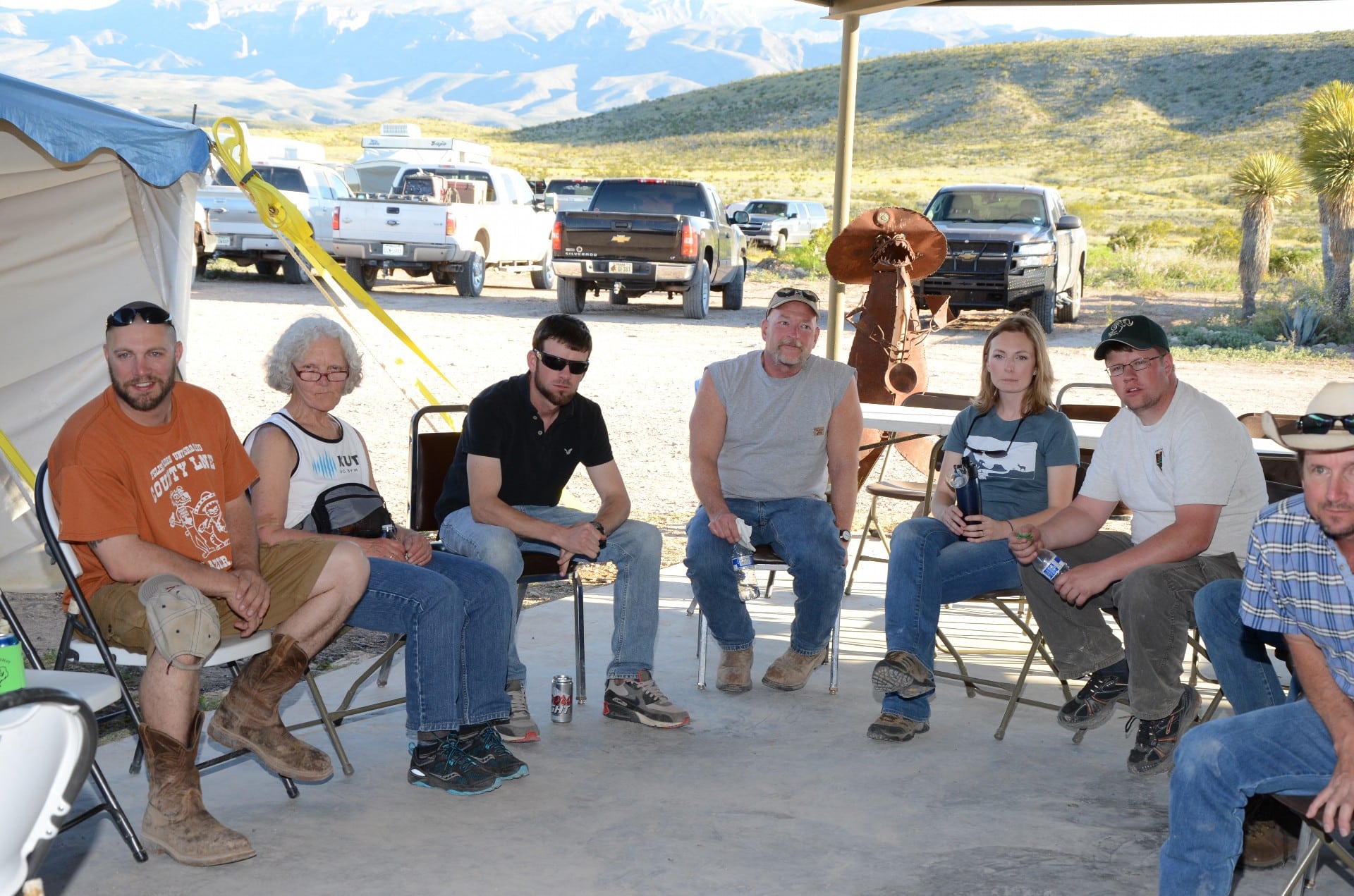About Bighorn Sheep
Habitat of Texas Bighorn Sheep
Habitat
Desert bighorn sheep thrive in steep, rocky terrain, which offers them escape routes from predators, bedding areas, and lambing sites. Remarkably agile, they navigate cliff faces with ease, using ledges as narrow as two inches for footholds and traversing spans as wide as 20 feet. Their cloven hooves, sharp-edged, elastic, and concave, enable them to move swiftly over level ground at 30 miles per hour and scramble up mountain slopes at 15 mph.
Food
These bighorns graze and browse on a wide variety of plant species, with a preference for green grasses. In the arid Chihuahuan Desert, where green grasses are scarce for most of the year, they supplement their diet with various plants, including cacti. Their complex nine-stage digestive process maximizes nutrient extraction from their food.

Characteristics and Habits of Bighorn Sheep
Characteristics
Desert bighorn sheep, stocky and heavy-bodied, resemble mule deer in size. Mature rams weigh between 125 to 200 pounds, while ewes are slightly smaller. Their padded hooves enable them to scale steep, rocky terrain with agility. Bighorns rely on their keen eyesight to detect predators such as mountain lions, coyotes, and bobcats, using their climbing ability to escape. Both sexes grow horns soon after birth, with horn growth continuing throughout life. Older rams develop impressive sets of curling horns, while ewes’ horns are smaller and lighter. Bighorns primarily feed on grasses, sedges, and forbs.
Desert Adaptations
These sheep have evolved to thrive in the desert’s harsh conditions, with their body temperature capable of safely fluctuating several degrees. During the day, they seek shade under trees and in caves to escape the heat. Some desert bighorns can go for weeks or months without visiting water sources, sustaining themselves from food and rainwater collected in temporary rock pools. They possess the remarkable ability to lose up to 30 percent of their body weight and still survive, quickly recovering after drinking water.
Social Life
During the breeding season, rams battle for dominance, with the victor gaining possession of ewes. Rams charge head-on, crashing their horns together until one submits. Bighorns typically live in separate ram and ewe bands throughout the year, coming together during the breeding season, usually from July to October. Gestation lasts about six months, with lambs typically born in late winter.
References
- ^ Caprinae Specialist Group (1996). Ovis canadensis ssp. nelsoni. 2006. IUCN Red List of Threatened Species. IUCN 2006. www.iucnredlist.org. Retrieved on 11 May 2006.
- ^ a b c d e f McCutchen, H.E. (1995). “Desert Bighorn Sheep”. In Stohlgren, T.J. (PDF). The Interior West. In: Our Living Resources: A report to the nation on the distribution, abundance, and health of U.S. plants, animals, and ecosystems. Washington, D.C.: U.S. Geological Survey.
- ^ a b c d e f “Desert Bighorn Sheep of Cabeza Prieta NWR”. Cabeza Prieta National Wildlife Refuge. U.S. Fish and Wildlife Service. Retrieved 2007-08-14.
- ^ Seton, E.T. (1929). Lives of game animals. New York: Doubleday. Vol 3.
- ^ Buechner, H.K. (1960). The bighorn sheep in the United States: its past, present, and future. Wildlife Monograph 4.
- ^ Edward H. Saxton (March 1978). “Saving the Desert Bighorns”. Desert Magazine 41 (3). Retrieved 2008-04-27.
- ^ van Wyk, Peter (2003). Burnham: King of Scouts. Trafford Publishing. ISBN 1-4120-0901-4.
- ^ “San Andres National Wildlife Refuge home page”. United States Fish and Wildlife Service. Retrieved 2009-01-18.
- ^ “Endangered Peninsular Bighorn Sheep”. Bighorn Institute. Retrieved 2009-01-18.
^ Lee, Mike (March 23, 2008). “Bighorns facing smaller habitat – Federal agency wants to reduce protected area by more than 50%”. San Diego Union Tribune.
INFORMATION AND STATISTICS FROM TEXAS PARKS AND WILDLIFE
All of this content is taken from the Texas Parks & Wildlife Department Website
Background
The Sierra Diablo Mountains population, in Culberson and Hudspeth counties, is a result of two successful releases of pen-raised sheep, consisting of 4 rams and 3 ewes in June 1973, and 3 rams and 4 ewes in January 1979. This herd grew to an estimated 100 head in early 1989. It was supplemented with 3 rams from the Sierra Diablo Wildlife Management Area (SDWMA) pens in April 1988, and 28 rams and 8 ewes from the Area pens in October 1989.
An additional 10 yearling rams and 1 ewe were released from the brood pen facility in April, 1992 and 25 rams were released in December, 1993. In May 1997, because of ongoing disease problems, the Sierra Diablo Wildlife Management Area brood pen facility was vacated. Forty-five sheep were released into the north end of the Sierra Diablo Mountains. This release consisted of 12 rams, 21 ewes, and 12 lambs.
The Elephant Mountain Wildlife Management Area (EMWMA) herd, in Brewster County, resulted from a release of 10 rams and 10 ewes on February 4, 1987. A supplemental release of 3 rams occurred in April 1988. All of these were pen-raised bighorns from the SDWMA brood facility. These sheep have since increased in number substantially.
The bighorns in the Sierra Vieja Mountains of Presidio County are the result of a release of 4 rams and 1 ewe from the 600-acre Chilicote Ranch brood pasture on March 16, 1987. More sheep were scheduled for release, but the attempt was aborted when the animals could not be trapped.
The Van Horn Mountains herd, in Culberson County, resulted from a release of wild-trapped bighorns from Nevada. In October 1987, 25 sheep, consisting of 5 rams and 20 ewes, were released. An additional 4 rams and 11 ewes were wild-trapped in Nevada and released in October 1988. A total of 22 of these sheep were fitted with telemetry collars to assist in evaluating the restocking effort. High predation losses to mountain lions and drought conditions initially resulted in a decline of the released broodstock.
The Baylor Mountains herd, in Culberson County, resulted from a release of 2 rams and 8 ewes, which were wild-trapped in Nevada in October 1988. This release was supplemented with 4 rams and 7 ewes, in December 1988 from the Chilicote Ranch brood pasture. A total of 15 sheep released in the Baylor Mountains were radio collared to facilitate evaluation of the restocking effort.
The Beach Mountains, in Culberson County, were restocked in May 1991 with 26 bighorns, which were in a temporary holding pen on the Beach Mountain Ranch. These sheep consisted of 1 mature ram, 5 mature ewes, 13 yearling rams, and 4 yearling ewes relocated from the Sierra Diablo brood facility in December 1990, plus 3 lambs born in the holding pen. The Beach Mountains received an additional 12 bighorns from the brood facility in November 1992 consisting of 2 rams and 10 ewes. The sheep were placed in a soft release holding pen awaiting release. These sheep, plus 9 lambs born in the holding pen, were released in June 1993.
In October 1995, 20 bighorn sheep (16 ewes and 4 rams) were transplanted from Nevada to the Black Gap Wildlife Management Area (BGWMA) in Brewster County. Three rams from the EMWMA were subsequently transplanted to augment the existing population and assure breeding. In December 1996, 5 more rams and 5 ewes were transplanted to BGWMA. An additional release of 15 adult ewes and 5 lambs from Nevada was completed in January 1998. Forty-five desert bighorn sheep (23 ewes and 22 rams) were transplanted from Elephant Mountain Wildlife Management Area to Black Gap Wildlife Management Area in December of 2001. All 23 of the ewes and 19 of the rams were fitted with telemetry collars to assist in evaluating the population augmenting effort.
Wildlife managers have recognized the need for systematic surveys to determine desert sheep numbers and trends for many years. During the 1950s many techniques were introduced to determine bighorn sheep populations but most survey methods and census techniques were found to be inadequate. Desert bighorn sheep surveys improved through time as technology advanced. Fall helicopter surveys consistently produced narrower ram:ewe ratios, better correlation of fall lambs to annual recruitment, consistent sex ratios, reliable sex:age ratios, and increased total observations. Systematic desert bighorn sheep aerial population surveys did not occur in Texas prior to 1990. Annual fall helicopter surveys were initiated in West Texas during the fall of 1990.
Observed Population
2021 – 898 Sheep (Excludes Big Bend)
- Rams: 293
- Ewes: 469
- Lambs: 106
2019 – 1,112 Sheep
- Rams: 328
- Ewes: 531
- Lambs: 253
2018 – 1,013 Sheep
- Rams: 323
- Ewes: 496
- Lambs: 194
2017 – 1,142 Sheep
- Rams: 330
- Ewes: 453
- Lambs: 259
2010 – 1,115 Sheep
- Rams: 364
- Ewes: 569
- Lambs: 182
2009 – 1,144 Sheep
- Rams: 372
- Ewes: 589
- Lambs: 178
2008 – 1,193 Sheep
- Rams: 365
- Ewes: 595
- Lambs: 210
2007 – 983 Sheep
- Rams: 303
- Ewes: 483
- Lambs: 189
2006 – 822 Sheep
- Rams: 216
- Ewes: 412
- Lambs: 181
2005 – 440 Sheep
- Rams: 130
- Ewes: 216
- Lambs: 86
2004 – 581 Sheep
- Rams: 151
- Ewes: 300
- Lambs: 109
Join Today
Your membership and participation in TBS activities can help make this dream a reality. Together, we can ensure a future where bighorn sheep thrive in their natural habitats, enriching the landscapes and communities of Texas for generations to come.
